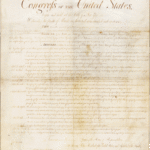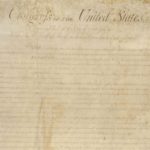There have been 27 amendments added to the Constitution since its ratification over 230 years ago. Each amendment has meant big changes to our system of government, and our nation as a whole. Discover the different amendments in the National Constitution Center’s learning module.
Bill of Rights Overview
The Bill of Rights is the first 10 amendments to the U.S. Constitution. These amendments guarantee essential rights and civil liberties, such as the freedom of religion, the right to free speech, the right to bear arms, trial by jury, and more, as well as reserving rights to the people and the states. After the Constitutional Convention, the absence of a bill of rights emerged as a central part of the ratification debates. Anti-Federalists, who opposed ratification, pointed to the missing bill of rights as a fatal flaw. Several states ratified the Constitution on the condition that a bill of rights be promptly added. Pop over to the National Constitution Center’s learning module to discover more!
The Bill of Rights: Debating the Amendments

In this lesson, students will examine a copy of twelve possible amendments to the United States Constitution as originally sent to the states for their ratification in September of 1789. Students will debate and vote on which of these amendments they would ratify and compare their resulting “Bill of Rights” to the ten amendments ratified by ten states that have since been known by this name.
The Constitution in Action – Origin of the Bill of Rights: Madison’s Amendments
History is the chronicle of choices made by actors/agents/protagonists in specific contexts. This lesson places students at the First Federal Congress and asks them to respond to the amendments James Madison proposed on June 8, 1789. Which of Madison’s proposals should they amend to the Constitution? Should they consider amendments proposed at state ratifying conventions as well? Whatever they decide, should amendments be placed at the end of the Constitution or woven into the body of the text, as Madison preferred?
Congress and the Constitution
Use this information graphic to easily understand the House of Representatives and Senate and the articles and amendments in the Constitution.
Title IX
Title IX of the Education Amendments Act of 1972 prohibited discrimination on the basis of sex in educational settings. The law applied to any educational institution that received federal funding. This lesson has students learn about what Title IX does and explore its impact on gender equality today.
Civil Rights
While the Reconstruction Amendments were an important step in ensuring equal rights for all people, regardless of race, racial injustices throughout the United States continued into the late 19th and 20th centuries, leading to the Civil Rights movement of the 1960s, and the passages of Supreme Court decisions and legislation, including Brown v. Board of Education, the Civil Rights Act of 1964, and the Voting Rights Act of 1965. Visit the National Constitution Center’s learning module to learn more about the freedom struggle and civil rights.
The Constitution in Action – Origin of the Bill of Rights: State Amendments
History is the chronicle of choices made by actors/agents/protagonists in specific contexts. This lesson places students at a critical moment in our nation’s founding, when Americans considered whether to ratify the Constitution. Should they agree to the document as-is, without making any changes? Students will examine and evaluate numerous amendments proposed at state ratifying conventions. Only by looking at the full sweep of amendments offered by the states can students understand the historical context of the Bill of Rights.
Bill of Rights

The Bill of Rights is on permanent display at the National Archives in Washington, DC. This original joint resolution of Congress proposed 12 amendments to the United States Constitution, but only 10 were ratified. Added to the Constitution in 1791 as the first 10 amendments, the Bill of Rights explicitly protected freedom of speech, of the press, of religion, and of assembly, among many other rights.
Founding Documents: The Bill of Rights Podcast
The Bill of Rights is the first ten amendments to our Constitution. Why do we have one? What does it “do”? And what does it really, really do? Our guests are Linda Monk, Alvin Tillery, David O. Stewart, Woody Holton, David Bobb, and Chuck Taft.
This short episode includes a one-page Graphic Organizer for students to take notes on while listening, as well as discussion questions on the back side.